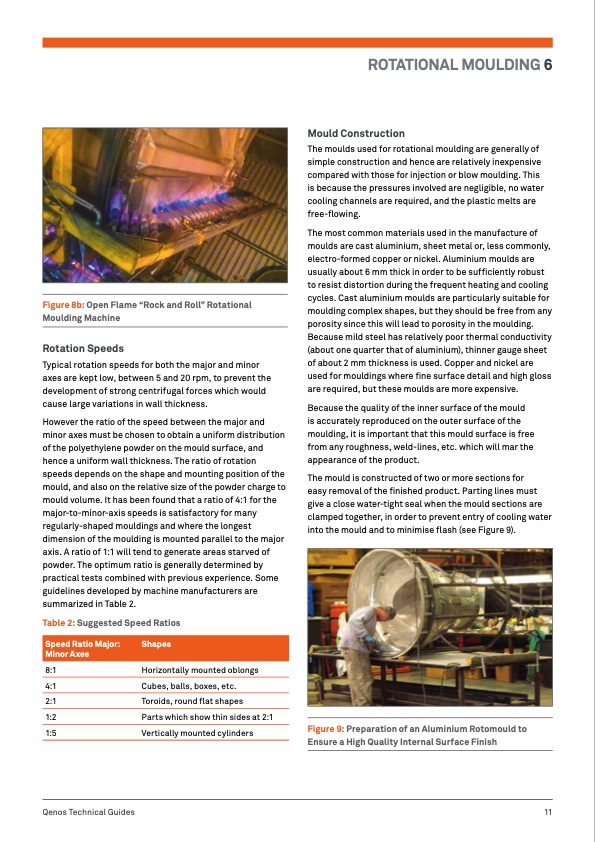
PDF Publication Title:
Text from PDF Page: 013
Figure 8b: Open Flame “Rock and Roll” Rotational Moulding Machine Rotation Speeds Typical rotation speeds for both the major and minor axes are kept low, between 5 and 20 rpm, to prevent the development of strong centrifugal forces which would cause large variations in wall thickness. However the ratio of the speed between the major and minor axes must be chosen to obtain a uniform distribution of the polyethylene powder on the mould surface, and hence a uniform wall thickness. The ratio of rotation speeds depends on the shape and mounting position of the mould, and also on the relative size of the powder charge to mould volume. It has been found that a ratio of 4:1 for the major-to-minor-axis speeds is satisfactory for many regularly-shaped mouldings and where the longest dimension of the moulding is mounted parallel to the major axis. A ratio of 1:1 will tend to generate areas starved of powder. The optimum ratio is generally determined by practical tests combined with previous experience. Some guidelines developed by machine manufacturers are summarized in Table 2. Table 2: Suggested Speed Ratios ROTATIONAL MOULDING 6 Mould Construction The moulds used for rotational moulding are generally of simple construction and hence are relatively inexpensive compared with those for injection or blow moulding. This is because the pressures involved are negligible, no water cooling channels are required, and the plastic melts are free-flowing. The most common materials used in the manufacture of moulds are cast aluminium, sheet metal or, less commonly, electro-formed copper or nickel. Aluminium moulds are usually about 6 mm thick in order to be sufficiently robust to resist distortion during the frequent heating and cooling cycles. Cast aluminium moulds are particularly suitable for moulding complex shapes, but they should be free from any porosity since this will lead to porosity in the moulding. Because mild steel has relatively poor thermal conductivity (about one quarter that of aluminium), thinner gauge sheet of about 2 mm thickness is used. Copper and nickel are used for mouldings where fine surface detail and high gloss are required, but these moulds are more expensive. Because the quality of the inner surface of the mould is accurately reproduced on the outer surface of the moulding, it is important that this mould surface is free from any roughness, weld-lines, etc. which will mar the appearance of the product. The mould is constructed of two or more sections for easy removal of the finished product. Parting lines must give a close water-tight seal when the mould sections are clamped together, in order to prevent entry of cooling water into the mould and to minimise flash (see Figure 9). Figure 9: Preparation of an Aluminium Rotomould to Ensure a High Quality Internal Surface Finish Speed Ratio Major: Minor Axes Shapes 8:1 4:1 2:1 1:2 1:5 Horizontally mounted oblongs Cubes, balls, boxes, etc. Toroids, round flat shapes Parts which show thin sides at 2:1 Vertically mounted cylinders Qenos Technical Guides 11PDF Image | ROTATIONAL MOULDING Guide

PDF Search Title:
ROTATIONAL MOULDING GuideOriginal File Name Searched:
TG6Roto.pdfDIY PDF Search: Google It | Yahoo | Bing
Development of a solar powered Electric Ship The Electricship website originally started off as a project to develop a comprehensive renewable, affordable, modular electric ship... More Info
Modular Boat Hull Composite The case for a unsinkable, modular composite hybrid boat hull... More Info
MS Burgenstock Hybrid Electric Catamaran Lake Lucerne Unique shuttle servicing Lucerne to the Burgenstock Resort... More Info
Ground Power Unit GPU Powered by Lithium Ion Batteries The goal of the Ground Power Unit is to provide a readily accessible, modular, ready-to-power solution for remote power... More Info
| CONTACT TEL: 608-238-6001 Email: greg@electricship.com | RSS | AMP |